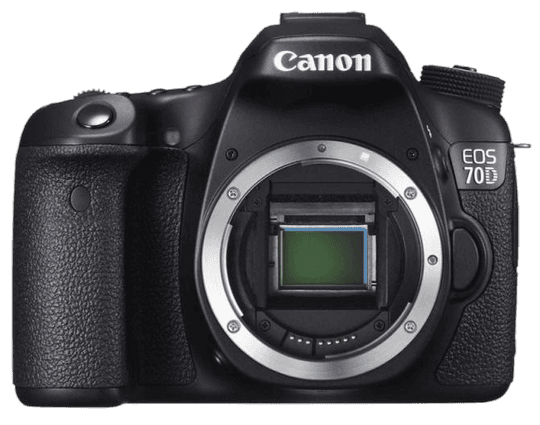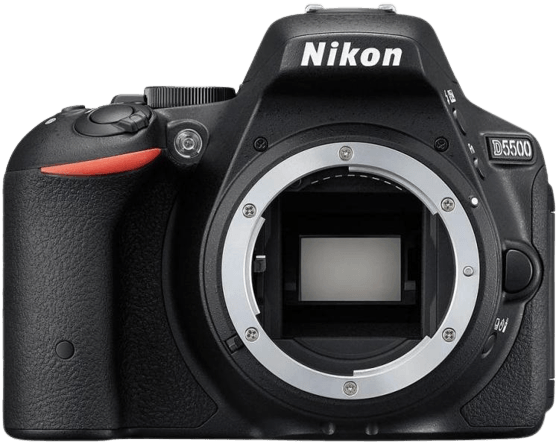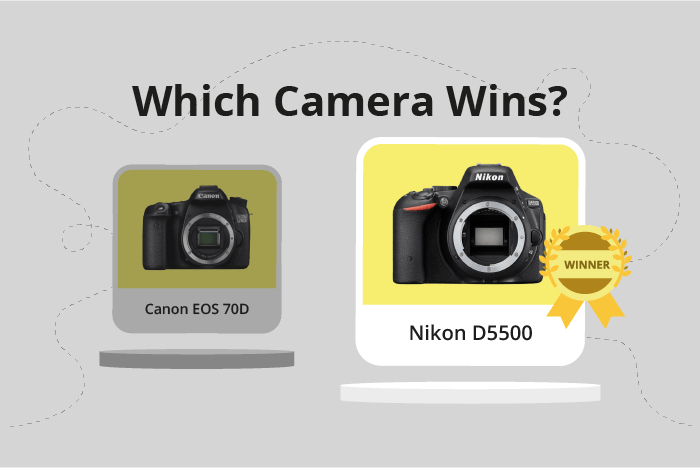Canon EOS 70D vs Nikon D5500 Comparison
Canon EOS 70D

Nikon D5500

The Nikon D5500 edges out the Canon EOS 70D with a score of 61/100 compared to 60/100. Both DSLR cameras share the same release year – 2013 for the Canon and 2015 for the Nikon. The Canon EOS 70D initially retailed at $1199, while the Nikon D5500’s launch price was $900.
The Canon EOS 70D is larger and heavier, measuring 139 x 104 x 79mm and weighing 1.66lbs. This heft may offer a more solid and stable feel during shooting. On the other hand, the Nikon D5500 is lighter and more compact at 0.93lbs and dimensions of 124 x 97 x 70mm, making it more portable and easier to carry around.
Considering the slight difference in scores, the Nikon D5500 is the winner for its better portability and affordability. However, the Canon EOS 70D still has merit for those who prefer a more substantial camera.
Canon EOS 70D vs Nikon D5500 Overview and Optics
The Nikon D5500 outperforms the Canon EOS 70D in optics, scoring 65/100 compared to the 70D’s 58/100. Both cameras share several specifications, including a CMOS sensor, APS-C sensor size, and a lack of image stabilization. However, the D5500 has a higher DXOMARK score for the sensor at 84, compared to the 70D’s 68, and boasts 24.2 megapixels, while the 70D has 20.2 megapixels.
The Nikon D5500’s higher DXOMARK score and increased megapixels contribute to its superior image quality. Its Expeed 4 processor also provides better performance than the 70D’s Digic 5+ processor. The D5500’s Nikon F DX lens mount offers compatibility with a wide range of lenses, allowing for greater versatility and creative options.
Despite losing in overall optics, the Canon EOS 70D has its advantages, particularly in shooting speed. With a shooting speed of 7 frames per second (fps), it surpasses the D5500’s 5 fps. This makes the 70D more suitable for capturing fast-moving subjects, such as sports and wildlife photography. The 70D’s Canon EF-S lens mount also provides access to Canon’s extensive collection of lenses.
Considering the optics, the Nikon D5500 stands out for its superior image quality and versatile lens options. However, the Canon EOS 70D’s faster shooting speed makes it a strong competitor for specific photography needs. Ultimately, the choice between these two cameras will depend on individual preferences and the intended use of the camera.
Canon EOS 70D vs Nikon D5500 Video Performance
The Nikon D5500 emerges as the superior camera in terms of video capabilities, outscoring the Canon EOS 70D by 27 points with a video score of 70/100. Both cameras share some common specifications such as Full HD max video resolution and max video dimensions of 1920 x 1080. However, the Nikon D5500 excels in certain aspects, making it the better choice for video recording.
One of the key advantages of the Nikon D5500 is its higher max video frame rate of 60fps, compared to the Canon EOS 70D’s 30fps. This allows for smoother and more detailed video footage, particularly in fast-moving scenes. Additionally, the Nikon D5500 comes with built-in time-lapse functionality, which enables users to create stunning time-lapse videos without the need for external accessories or software.
On the other hand, the Canon EOS 70D does not offer any significant advantages in video capabilities over the Nikon D5500. Its lower video score of 43/100 and the absence of built-in time-lapse functionality make it less appealing for those seeking a camera primarily for video recording.
Taking these factors into consideration, it is clear that the Nikon D5500 outperforms the Canon EOS 70D in the realm of video capabilities. With a higher video score, smoother frame rate, and built-in time-lapse functionality, the Nikon D5500 is the better choice for videographers and those looking to capture high-quality video footage.
Canon EOS 70D vs Nikon D5500 Features and Benefits
The Canon EOS 70D outperforms the Nikon D5500 with a feature score of 70/100, a difference of 11 points compared to the Nikon’s 59/100. Both cameras share several features, including a touchscreen, flip screen, GPS absence, WIFI connectivity, and lack of Bluetooth. However, there are differences that make the Canon EOS 70D a better choice.
The Canon EOS 70D boasts a higher screen resolution of 1,040,000 dots, slightly above the Nikon D5500’s 1,037,000 dots, providing a sharper image display. Additionally, the Canon EOS 70D’s 3-inch screen size is only marginally smaller than the Nikon D5500’s 3.2-inch screen. These factors contribute to the Canon EOS 70D’s higher feature score.
On the other hand, the Nikon D5500 also has some advantages. Its larger 3.2-inch screen size offers a slightly bigger display for image previews and menu navigation. Despite a marginally lower screen resolution, the difference is minimal, and the Nikon D5500 still delivers excellent image quality on its display.
Taking these factors into account, it is evident that the Canon EOS 70D is a superior camera in terms of features. Its higher screen resolution and overall feature score make it a better choice for photographers seeking a more advanced camera. The Nikon D5500, however, remains a viable option for those who prioritize a larger screen size and are less concerned with the minor difference in screen resolution.
Canon EOS 70D vs Nikon D5500 Storage and Battery
The Canon EOS 70D outperforms the Nikon D5500 in storage and battery with a score of 37/100, while the Nikon D5500 scores 35/100. Both cameras share the same storage specifications, having one memory card slot and accepting SD, SDHC, and SDXC cards. However, neither camera offers USB charging.
The Canon EOS 70D has a better battery life, providing 920 shots per charge compared to the Nikon D5500’s 820 shots. This longer battery life is due to the Canon’s LP-E6 battery type. On the other hand, the Nikon D5500 uses an EN-EL14 battery, which results in a shorter battery life.
Although the Canon EOS 70D has a slightly higher score and longer battery life, the Nikon D5500 still offers decent battery performance and identical storage options. Ultimately, the choice between these two cameras depends on the user’s preferences and needs, but the Canon EOS 70D does hold a slight advantage in the storage and battery category.
Alternatives to the Canon EOS 70D and Nikon D5500
Are you still undecided about which camera is right for you? Have a look at these popular comparisons that feature the Canon EOS 70D or the Nikon D5500:

